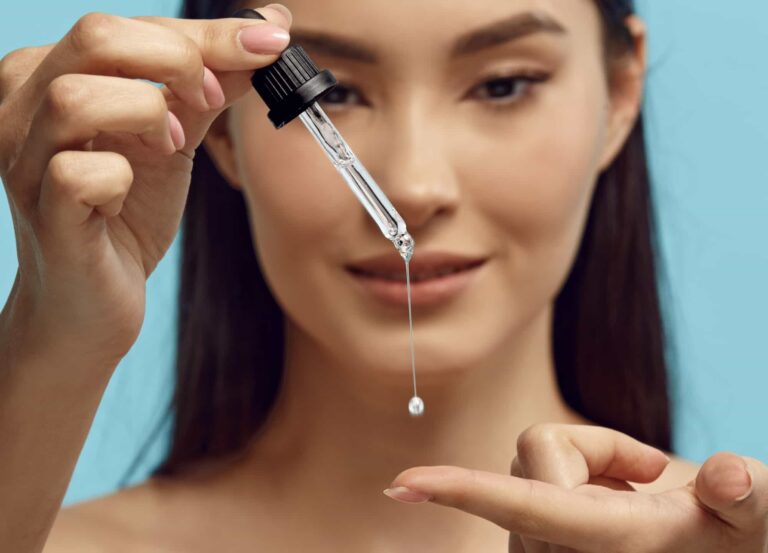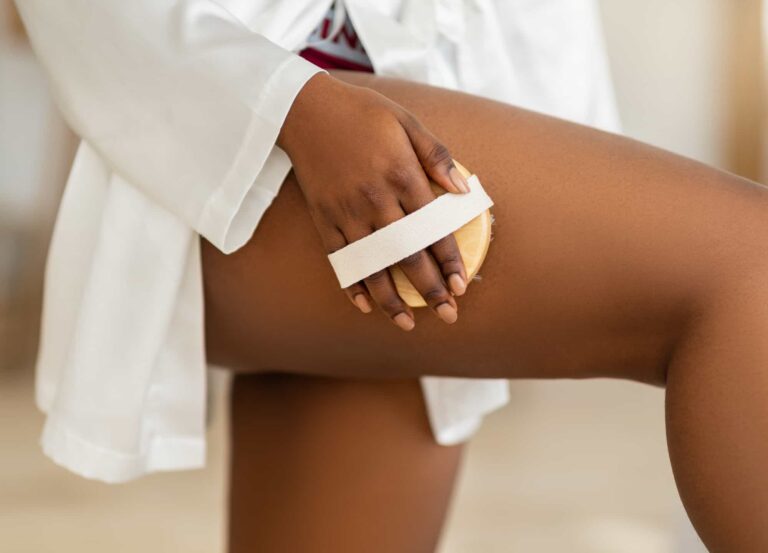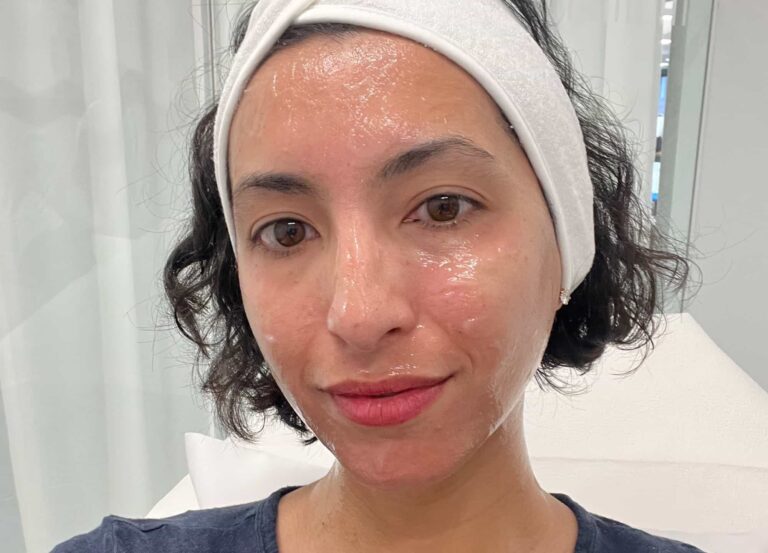Whether you’re prone to eczema on your hands or experience seasonal flakes, you’re not alone—dry skin is one of the most common skin concerns. And while some people are naturally predisposed to dry skin (blame it on genetics), it can be worse during the cooler months, in which cold air leads to a dip in skin’s moisture content.
One major challenge is that dry skin tends to be cyclical. It’s indicative of a compromised skin barrier, which allows for more transepidermal water loss, or TEWL. Not only does a higher rate of TEWL lead to dehydration, but it can also make it tough for the skin barrier to rebalance itself. The end result? Rough or flaky skin, signs of irritation (like redness or stinging), and even more exaggerated fine lines and wrinkles.
The good news: This is where nourishing skin-care products and good habits can help. Here, dermatologists share their best tips to alleviate extremely dry skin—and keep you comfortable year-round.
What causes dry skin?
Genetics plays a big role in dry skin, in which the skin barrier doesn’t function as well as it should. Beyond that, external factors can also have an impact—which is why someone with any skin type, even acne-prone skin, can experience dryness.
For many, dryness is a seasonal issue; you can thank the combination of low temperatures, decreased humidity, and blustery winds for a super-flaky, dry dermis. In the face of this, “skin reacts in several ways—microscopically, increased amounts of water are lost from the inner layers of skin to the environment, and skin cells proliferate at a higher rate without exfoliating off the body, leading to thicker, flakier, and itchier skin,” says Dr. Nikhil Dhingra, a board-certified dermatologist in New York City. On top of that, he adds, cold temperatures can increase blood flow to the skin, increasing skin redness, and can interrupt skin barrier function.
If you already have a skin condition like psoriasis or eczema, it can also flare up during this season and require some extra TLC too. “You will need to moisturize frequently, using a thicker moisturizer,” says Dr. Michele Green, a board-certified dermatologist in New York City.
The same goes for inflammatory skin conditions like acne. “If you suffer from acne, your skin will produce less oil and can become dehydrated, causing more redness and breakouts,” she says. “When skin is dry, acne sufferers should change to hydrating treatment products that will moisturize their skin without causing acne.”
How should you prevent and treat dry skin?
Let’s start in the shower. First, turn down the temperature; long, hot showers only worsen dryness by removing sebum, your skin’s natural source of moisture. “Wash [with soap] only your underarms, feet, hands, bikini area, and face [when showering],” suggests Beverly Hills, California, board-certified dermatologist Dr. Ava Shamban. “Limit showers to once daily, with lukewarm but not hot water and for no more than 10 minutes—this will help preserve the skin’s natural oil barrier,” says Dr. Dhingra.
When showering, Dr. Dhingra suggests using extra-gentle soaps. “I advocate for fragrance-free soaps with a creamy finish,” he says. “I also recommend caution with many of the products labeled organic or natural, as they are often scent heavy and a frequent cause of irritation and dryness.”
Next, rethink your body-care habits. Moisturizing frequently is key to fighting off the flakes and keeping skin feeling comfortable. “Protecting the skin barrier with rich body lotions on arms, legs, hands, face, and lips helps keep dry air and wind away from the skin surface and unable to wreak total havoc,” says Dr. Krant. Consider your formulation too: If you usually use a lightweight gel-cream, consider switching it up. “Moisturizing with a thick cream rich in ceramides and hyaluronic acid helps to attract water to the skin’s surface and trap water sitting there,” he says. “This should be done within five minutes of coming out of the shower, after patting but not rubbing dry, to seal some of that extra water into the skin.”
You can also incorporate moisture throughout your skin-care routine, like cleansing with a milky or oil-based face wash and seeking out moisturizers with lipids, such as ceramides and fatty acids. Unfortunately, you might also want to retire your skin-care device, for irritation reasons. “Keep rough scrubbing [and] exfoliating to a minimum, to help natural skin oils stay in place and [to] reduce frictional skin damage, which otherwise creates new dryness and flaking and becomes cyclical,” says NYC board-certified dermatologist Dr. Jessica Krant.
Outside the bathroom, humidifiers work wonders for keeping dry skin at bay. “A humidifier maintaining at least 50% humidity can be helpful, as long as [it is] cleaned regularly—dust mites and mold growing in humidifiers can be extremely counterproductive,” says Dr. Dhingra. He also suggests wearing breathable, organic fabrics and avoiding extremely fitted clothing in order to allow skin room to breathe. Finally, it’s not just about the topical products; make sure you’re drinking enough water too.
The best ingredients for dry skin
When it comes to moisturizers, there are three types: lotions (heavy on water content, relative to soothing ingredients), creams (heavier in fats than water), and ointments (greasy, with a Vaseline-like finish). If you’re dealing with dry skin, “look for heavier creams and even greasy-feeling emollients,” says Dr. Krant.
According to Dr. Dhingra, there are three critical components to a good moisturizer: a humectant, which lures water onto a surface to which it is applied; an emollient, which soothes the skin; and an occlusive, which traps water, humectants, and emollients so they aren’t lost to the environment. “Fortunately, these three elements are found in most good—and inexpensive!—moisturizers at the drugstore,” he says. (Fun fact: There are some sneaky hydrators out there; some alpha hydroxy acids, such as lactic acid, actually serve as humectants. The more you know.)
The best occlusive agents to look for when searching for a moisturizer include ceramides, shea butter, and petrolatum (the primary ingredient in petroleum jelly), whereas hyaluronic acid and glycerin are important humectants. Dr. Dhingra also suggests looking for niacinamide, or vitamin B3, when shopping for a cream, since it’s a potent anti-inflammatory ingredient (not to mention an antioxidant) that’s helpful for offsetting dryness.
“I’m not a big advocate of fancy, expensive skin care—I think a good body moisturizer is cream- or ointment-based, fragrance-free, and suitable for even the most sensitive skin types,” says Dr. Dhingra. “For the face, a good daily sunscreen-containing moisturizing lotion with SPF, ceramides, niacinamide, and hyaluronic acid is a good starting point.”
For moisturizing the body, Dr. Dhingra suggests CeraVe Moisturizing Cream ($19.99), which “is fantastic, inexpensive, and absorbed nicely by the skin [and won’t ruin your clothing],” he says. “For those stubborn scaly, dry, itchy patches, CeraVe Healing Ointment ($10.99) or Aquaphor Healing Ointment ($4.99) dabbed on the skin after the shower can reverse that damage quickly.” Dr. Krant also loves La Roche-Posay and recommends the Lipikar Balm ($19.99). She’s also a fan of Aveeno Skin Relief Intense Moisture Repair Cream ($11.19) as well as the Neutrogena Norwegian Formula Hand Cream ($5.49) for after handwashing. “They are bland and gentle but rich enough to stay all day and reduce itching while keeping skin hydrated,” she says.
For the face, meanwhile, consider Cetaphil Facial Moisturizer SPF 50 ($16.49), which is above the minimum of SPF 30 recommended by the American Academy of Dermatology. In the evening, “CeraVe Facial Moisturizing Lotion PM ($13.69) is a great lightweight starting moisturizer for nighttime use—it’s nonclogging and does a good job undoing damage,” Dr. Dhingra says. “If it’s still not enough, La Roche-Posay Double Repair Face Moisturizer ($19.99) and Avène Tolerance Control Skin Recovery Cream ($36) are nice, thicker options for exceptionally dry facial skin.”
What to avoid with dry skin
For starters, “Avoid soaps, alcohol-based ingredients, water-based gels, light lotions, and solutions,” suggests Dr. Krant. Dr. Dhingra also advises patients to decrease the use of certain anti-aging and medicated products, like retinoids and some acid-based treatments—for instance, going from daily use to every other night.
Also, swap out your gel- and foam-based cleansers for a more gentle, hydrating cleanser, to avoid overdrying your skin—Dr. Dhingra loves La Roche-Posay Toleriane Hydrating Cleanser ($14.99).
Finally, all fragrance should be avoided when it comes to caring for dry skin. “Any fragrance-containing products that touch your skin should be avoided,” he says. “Think outside skin care—laundry detergent and fabric softener are often overlooked as things that can perpetuate irritation.”











